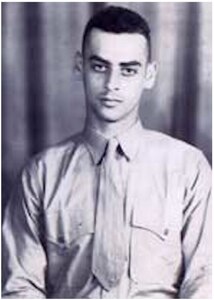Funeral Announcement For Marine Killed During World War II (Carbone, J)17-109 | September 22, 2017
The Defense POW/MIA Accounting Agency (DPAA) announced today that the remains of a U.S. serviceman, recently accounted-for from World War II, are being returned to his family for burial with full military honors. Marine Corps Pvt. Joseph C. Carbone, 20, of Brooklyn, New York, will be buried September 30 in his hometown. In November 1943, Carbone was assigned to Company K, 3rd Battalion, 2nd Marines, 2nd Marine Division, which landed against stiff Japanese resistance on the small island of Betio in the Tarawa Atoll of the Gilbert Islands, in an attempt to secure the island. Over several days of intense fighting at Tarawa, approximately 1,000 Marines and Sailors were killed and more than 2,000 were wounded, but the Japanese were virtually annihilated. Carbone died on the first day of battle, Nov. 20, 1943. The battle of Tarawa was a huge victory for the U.S. military because the Gilbert Islands provided the U.S. Navy Pacific Fleet a platform from which to launch assaults on the Marshall and Caroline Islands to advance their Central Pacific Campaign against Japan. In the immediate aftermath of the fighting on Tarawa, U.S. service members who died in the battle were buried in a number of battlefield cemeteries on the island. In May 1946, the 604th Quartermaster Graves Registration Company of the American Graves Registration Services (AGRS) had recovered 532 sets of remains from burial sites across the Tarawa Atoll and interred them in Lone Palm Cemetery. The remains that could not be identified were designated as “Unknowns.” In November 1946, the U.S. Army began disinterment to bring the remains to Oahu for identification at the Central Identification Laboratory. In 1947, remains designated Unknown X-206 were sent to the Schofield Barracks Central Identification Laboratory in Hawaii for analysis. When the X-206 could not be identified, they were reinterred at the National Memorial Cemetery of the Pacific in Honolulu. In October 2016, due to recent advances in forensic technology, DPAA began the exhumation of unknown remains associated with Tarawa from NMCP and sent the remains to the DPAA laboratory for analysis. To identify Carbone’s remains, scientists from DPAA and the Armed Forces Medical Examiner System used mitochondrial (mtDNA), which matched a family member, as well as dental and anthropological analysis, which matched his records, and circumstantial evidence. DPAA is grateful to the Department of Veterans Affairs for their partnership in this mission. Of the 16 million Americans who served in World War II, more than 400,000 died during the war. Currently there are 73,004 service members (approximately 26,000 are assessed as possibly-recoverable) still unaccounted for from World War II. Carbone’s name is recorded on the Tablets of the Missing at the NCMP, an American Battle Monuments Commission Cemetery, along with the others who are missing from WWII. A rosette will be placed next to his name to indicate he has been accounted for. For additional information on the Defense Department’s mission to account for Americans who went missing while serving our country, visit the DPAA website at www.dpaa.mil, find us on social media at www.facebook.com/dodpaa or call (703) 699-1420. |
We do not have information on individuals beyond what is listed on this site.
For more information, visit www.dpaa.mil or call 703-699-1420.
We are not associated with any government agency.

